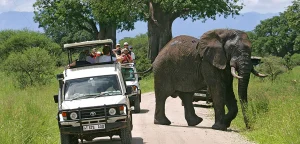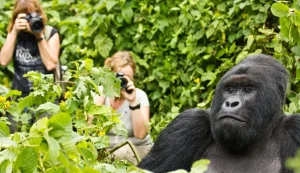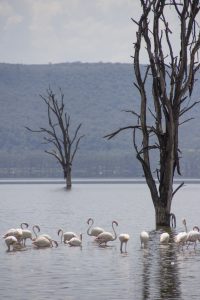Why should you visit national parks and reserves in Uganda?
Uganda’s national parks and reserves protect some of Africa’s richest biodiversity. They safeguard endangered species such as mountain gorillas and shoebill storks while offering unforgettable safari adventures. The country hosts ten national parks and over a dozen reserves, each with unique ecosystems ranging from savannahs and wetlands to rainforests and volcanic landscapes. Visitors experience wildlife encounters, cultural heritage, and breathtaking scenery, making Uganda one of Africa’s leading eco-tourism destinations. Top National Parks and Reserves to Visit in Uganda
What makes Bwindi Impenetrable National Park special?
Bwindi Impenetrable National Park is world-famous for its mountain gorillas. Almost half of the global gorilla population lives here, making it the best place to experience gorilla trekking. The park covers over 321 square kilometers of montane forest and is also a UNESCO World Heritage Site. Besides gorillas, Bwindi shelters over 120 mammals, 350 bird species, and numerous butterflies. Tourists visit Bwindi not only for gorillas but also for birdwatching, nature walks, and community cultural experiences with the Batwa people. Top National Parks and Reserves to Visit in Uganda
Why is Murchison Falls National Park a must-visit?
Murchison Falls National Park is Uganda’s largest protected area, covering about 3,893 square kilometers. The park is named after the dramatic Murchison Falls, where the Nile River forces through a 7-meter gorge before plunging 43 meters into a roaring cascade. Visitors enjoy game drives across savannah plains that host lions, leopards, elephants, giraffes, and buffaloes. Boat cruises along the Nile provide opportunities to spot hippos, crocodiles, and birds such as the shoebill. Its combination of big game safaris and natural wonders makes Murchison a top destination. Top National Parks and Reserves to Visit in Uganda
What can you experience in Queen Elizabeth National Park?
Queen Elizabeth National Park is Uganda’s most popular park due to its incredible diversity. It covers 1,978 square kilometers and stretches from Lake George to Lake Edward, connected by the Kazinga Channel. The park is home to over 95 mammal species and more than 600 bird species, making it a paradise for nature lovers. Tourists experience classic game drives, boat cruises, birdwatching, and cultural encounters. The Ishasha sector is world-famous for its tree-climbing lions, which attract photographers from across the globe.
Why should you visit Kidepo Valley National Park?
Kidepo Valley National Park is often described as Uganda’s most remote and untouched wilderness. Located in the northeast near the borders with Kenya and South Sudan, the park spans 1,442 square kilometers. Visitors find sweeping savannahs, rugged mountains, and an incredible variety of wildlife. Lions, cheetahs, ostriches, elephants, giraffes, and buffaloes thrive here. Kidepo also offers cultural encounters with the Karamojong and Ik people. Its remoteness ensures fewer crowds, giving visitors a true African wilderness experience.
What makes Kibale National Park famous?
Kibale National Park is Uganda’s primates capital, hosting over 13 species, including more than 1,500 chimpanzees. The park also shelters red colobus monkeys, L’Hoest’s monkeys, and mangabeys. Chimpanzee trekking is the main activity, giving visitors the chance to track and observe habituated chimpanzee groups. Kibale also boasts diverse birdlife with over 370 species. Its lush rainforest and guided nature walks make it a top destination for eco-tourism.
Why is Lake Mburo National Park worth visiting?
Lake Mburo National Park, located between Kampala and Bwindi, is the perfect stopover for travelers heading to southwestern Uganda. It covers 370 square kilometers and is Uganda’s smallest savannah park. Despite its size, the park hosts zebras, impalas, elands, buffaloes, and hippos. Tourists enjoy walking safaris, boat trips on Lake Mburo, and birdwatching. The park’s accessibility and diversity make it an excellent addition to Uganda itineraries.
What unique experiences does Semuliki National Park offer?
Semuliki National Park is located in western Uganda near the Congo border. The park is famous for its hot springs, particularly the Sempaya hot springs, which attract both tourists and locals. Semuliki protects lowland tropical forest, home to chimpanzees, forest elephants, and over 440 bird species. The park is culturally rich, with communities such as the Batwa and Bakonzo living nearby. Visitors enjoy forest walks, birding, and cultural experiences in addition to exploring the hot springs.
What makes Mgahinga Gorilla National Park important?
Mgahinga Gorilla National Park is part of the Virunga conservation area and is Uganda’s smallest park, covering 33.7 square kilometers. Despite its size, it protects mountain gorillas and golden monkeys, making it a unique destination. Visitors can trek gorillas, track golden monkeys, and hike the park’s volcanic peaks such as Mount Muhavura. The park also offers cultural encounters with the Batwa people, making it a combination of wildlife, adventure, and heritage.
Why should you visit Mount Elgon National Park?
Mount Elgon National Park lies in eastern Uganda, sharing its ecosystem with Kenya. It protects Mount Elgon, an extinct volcano with the largest volcanic base in the world. Tourists hike trails that lead to waterfalls, caves, and the Wagagai peak. The park hosts elephants, buffaloes, and monkeys, though its main attraction is hiking and birdwatching. Its cool climate and scenic trails attract nature lovers and adventure seekers alike.
What wildlife reserves in Uganda are worth exploring?
Beyond national parks, Uganda has several wildlife reserves that offer unique experiences. Popular reserves include:
- Ziwa Rhino Sanctuary – the only place in Uganda where you can track wild rhinos.
- Pian Upe Wildlife Reserve – a vast savannah home to cheetahs, roan antelopes, and ostriches.
- Toro-Semliki Wildlife Reserve – Uganda’s oldest reserve, protecting chimpanzees and diverse birdlife.
- Katonga Wildlife Reserve – a haven for antelopes, otters, and primates along the Katonga River.
These reserves complement the national parks by protecting different habitats and species.
When is the best time to visit Uganda’s national parks?
The best time to visit Uganda’s national parks is during the dry seasons from December to February and June to September. Wildlife is easier to spot as animals gather around water sources. Gorilla and chimpanzee trekking are also more enjoyable during dry conditions. The wet seasons (March–May and October–November) offer lush scenery and fewer crowds, making them ideal for birdwatching. Travelers should choose based on their preferred activities.
How much does it cost to visit national parks in Uganda?
The cost of visiting Uganda’s national parks varies depending on activities. Gorilla trekking permits cost $700 per person, while chimpanzee trekking permits range between $150 and $200. Park entrance fees generally range from $35 to $45 per day for foreign visitors. Safaris can be budget-friendly or luxurious depending on the choice of lodges, transport, and activities.
Why is Uganda called the Pearl of Africa?
Uganda is called the Pearl of Africa because of its unmatched natural beauty and diversity. From snowcapped mountains to tropical forests, savannahs, and lakes, Uganda’s landscapes host extraordinary biodiversity. The nickname highlights Uganda’s richness in culture, wildlife, and adventure opportunities. Visiting its parks and reserves allows tourists to experience why Winston Churchill gave the country this name. Top National Parks and Reserves to Visit in Uganda




